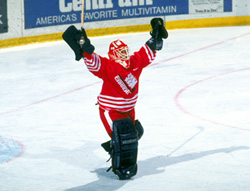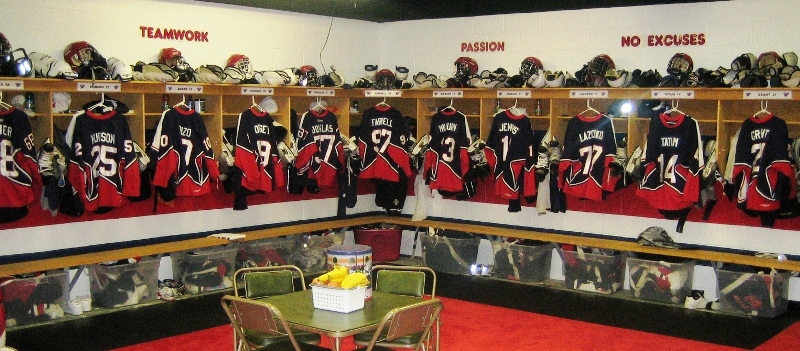Cara
Hedley Gives Can-Puck-Lit Its First Real Groove
 With
the hard-hitting, side-splitting hockey novel, Twenty Miles With
the hard-hitting, side-splitting hockey novel, Twenty Miles
‘Duh, duh, duh – The Sin Bin!’
Toad sang doom fully as I stepped into the penalty box. ‘Yeah, don’t
do us any favours, Ass Eyes!’ This, shouted in the direction of the
ref’s zebra back as she slammed the door. The box vibrated like the
inside of an old piano and I edged around Toad to sit on the bench. I
felt a gathering in my throat, adrenaline turning to venom, turning on
me; the slow, snake-eyed blink. So embarrassing to be caught like
that, acting out a private violence, frozen into a red split-second in
your mind, like dreaming of peeing and then wetting the bed. The
announcer drawled my penalty over the loudspeaker.
From Twenty Miles, by Cara
Hedley (Coach House Books, 2007)
by Nathaniel G. Moore
The Interview
I attended the Coach House fall
book launch dressed in a 2000 NHL all-star hockey jersey. And I was the
only one in such an ensemble. I didn’t get a chance to talk to Cara
Hedley then, but heard her read. The experience partially, though
not entirely, reminded me of when I waited in line with my brother for
three hours at Warden Woods mall in the early 1990s to get Patrick
Roy’s autograph. We were huge Habs fans and the next
in line when his handler said to the line, “No more that’s it,”
and my mom started yelling at Mr. Roy. Thankfully however, the amazing Evan
Munday put me in touch with Cara and I didn’t have to relive this
rejection and celebrity trauma in my professional life.
In
preparing this piece for Danforth Review, I get caught up in
setting and begin to pummel debut novelist Hedley with several sports
questions, like a goon without purpose or proper hydration. I start with
a smarmy baseball question, thinking she won’t budge, that she’ll
wait for the real questions to come in, but she takes the bait, or so I
think, and so begins our showdown. Hedley says when she was four, she
was hit “in the melon by a foul ball driven errant by the drunken
swing of my Dad's teammate.”
Despite the fact that it was a morning
game, Hedley’s father’s friend was clearly an alcoholic, and trying
to ruin her literary career from the get-go. “What else is there to do
but booze in a sport that's 90% sitting on a piece of wood?”
Hedley muses bravely. “The ball hitting my skull sounded like a
gong and, as the green morning faded to black, I knew I was destined to
write a novel not at all about baseball.”
And so, dear loyal readers of the Verdana-fonted national literary front
known as TDR, I present to you a most engaging account of both the work,
and the women who brought us, Twenty Miles.
 Hedley was born in Winnipeg the year The
Empire Strikes Back was released in theatres (1980). She has lived
in England and western Canada, and after playing hockey for the University
of Manitoba Bisons for three seasons, moved to Calgary where she
completed an MA in English Literature and Creative Writing. Hedley says
this hockey playing took place “a million years ago,” and believes
her former teammates are now mothers, teachers, businesswomen, writers,
and fire fighters. Every once and a while however, they get that urge,
when geography cooperates, one thing leads to another, “inevitably
someone will be wearing the old team sweats and inevitably someone
will bring up a story about the team's adopted child, King Kong
Beer Bong, and we'll all eat chips like it's 1998.” Hedley was born in Winnipeg the year The
Empire Strikes Back was released in theatres (1980). She has lived
in England and western Canada, and after playing hockey for the University
of Manitoba Bisons for three seasons, moved to Calgary where she
completed an MA in English Literature and Creative Writing. Hedley says
this hockey playing took place “a million years ago,” and believes
her former teammates are now mothers, teachers, businesswomen, writers,
and fire fighters. Every once and a while however, they get that urge,
when geography cooperates, one thing leads to another, “inevitably
someone will be wearing the old team sweats and inevitably someone
will bring up a story about the team's adopted child, King Kong
Beer Bong, and we'll all eat chips like it's 1998.”
Hedley
calls this "a phenomenon called Livin' the Dream, which strays
a bit from conventional definitions of this term--but, let's be honest,
hockey players aren't known for their observation of lexical standards."
Perhaps. But then again, Twenty Miles isn’t a standard of
anything; it’s sort of an anomaly. Where Judy Blume meets Bob
Probert, where Kathy Acker meets Manon Rheaume where…
 Hedley went on: “So it was
recently brought to my attention that this book is the most
shocking manifestation of Livin' the Dream ever in the history
of--well, of my friends. Should I be horrified or proud?” Hedley went on: “So it was
recently brought to my attention that this book is the most
shocking manifestation of Livin' the Dream ever in the history
of--well, of my friends. Should I be horrified or proud?”
I
suggest going with horrified, but that’s just me.
Hedley continued: “My family and
friends are happy about the book. Those who have
played hockey are excited to see their own experiences
reflected in the story, I think. Well, most of them
are happy about it, except for my friend--let's just call her
Number 12--who thinks the book's one giant insider leak, and fears
for the safety of our dating lives. I should reiterate here
that we're talking about a work of fiction. Pure fiction.
Other old teammates are getting existential with the book. They're
revisiting the past, trying to recognize themselves in the
characters, and asking the Big Questions, such as, "Who was it
who always ate burritos in the dressing room? Was that Warnick or
Boris?"
 Twenty Miles
is one of those perfect gift books, and seems a cohesive fit for any
generation, be it your sister, your brother, mom, dad, barber, coach,
bus driver. The Scarlets are hard-hitting, tough-talking hockey players.
There’s brash Toad, confident and witty, and there’s troubled Hal,
unofficial team captain, whose mother is terminally ill. There’s
French Pelly and there’s hilarious Heezer, who waitresses at Hooters
to pay the rent. And then there’s Iz. Iz has a long, fraught
relationship with her sport. Her dad, who died before she was born, was
a hockey star, and her grandparents have shaped her life around this
game that is supposed to be her destiny. But when she leaves her
grandmother behind for the university team, she can’t quite find her
own place in the game. Twenty Miles
is one of those perfect gift books, and seems a cohesive fit for any
generation, be it your sister, your brother, mom, dad, barber, coach,
bus driver. The Scarlets are hard-hitting, tough-talking hockey players.
There’s brash Toad, confident and witty, and there’s troubled Hal,
unofficial team captain, whose mother is terminally ill. There’s
French Pelly and there’s hilarious Heezer, who waitresses at Hooters
to pay the rent. And then there’s Iz. Iz has a long, fraught
relationship with her sport. Her dad, who died before she was born, was
a hockey star, and her grandparents have shaped her life around this
game that is supposed to be her destiny. But when she leaves her
grandmother behind for the university team, she can’t quite find her
own place in the game.
The rapid but effective introduction of
these bawdy gals is done with clean passes and enough excitement that
the reader is rarely bogged down in the books obvious setting, which,
because of the nature of the story, would have been easy to do, and a
tempting place to dwell considering Hedley’s background and love of
hockey. Even a Zamboni’s activity prior to a game, which for most
people is colossal filler, a time to go get more carb-laden pretzel
snacks, seems to, in its brief description, have poetic
significance.
The team gels on the page, and one can
imagine their banter long after the heavy dressing room door is closed,
and the coach begins to rant. The players are quirky, passionate, vulgar
but as well caring. The writing is rich and eloquent, occasionally
poetic tirades eclipse the banality of sports talk, creating a fresh and
lasting mood, highly readable and enjoyable.

Hedley says the family members and
friends who have not had a chance at being privy to the inside of a
women's hockey dressing room have been surprised by some parts of
the book. At the Winnipeg launch, Hedley publicly apologized to her
grandparents for certain profanities, deflecting the blame onto her
former teammates who were highly visible in red Scarlet Hockey T-shirts
her father had made for the event.
“Several friends of mine from the
Calgary writing community had books published this Fall, so it's been
nice to jump on the publishing and touring tilt-a-whirl at the same time
as them.”
I ask Hedley if she ever got into
fights on the ice, or in general. “Most of my fights have been with
writers. I dare you, poets: challenge me to an arm
wrestle. I. Will. Kill. You.” Dennis Lee,
Gary Barwin, Michael Knox, a. rawlings, you have
been warned.
TDR: Did you write this book in
regulation time, or go into overtime?
CH: Overtime.
Sudden Death. The scoreboard dripping red seconds over my helmet
(safety first, writers). I suspect most books go into
overtime: always another sentence to change, another comma to
shift, up until the buzzer goes, the flood guy miming a
throat slit as the Zamboni bears down on you in slow-motion.
TDR: Were you sad when the Winnipeg
Jets were offed? Were you obsessed with Dale Hawerchuck?
CH: No particular attachment to Dale Hawerchuk, but a
complicated emotional investment in the Winnipeg Jets that may or
may not stem from abandonment issues. We tried SO HARD to get them
to stay--we got Tom Friggin' Jackson to sing them songs!--but they still
just walked away.
TDR: What position did you play?
CH: As
a writer or a hockey player?
TDR: Don’t be cute. This isn’t Off The Record with Michael
Lansberg.
CH:
As a hockey player, I was Defense. Stay at Home, mainly.
None of this fancy-stick stuff. As a writer: it's all about
the fancy-stick. And, sadly, also all about staying at home.
TDR: Do hockey players make good
lovers?
CH:
Heh heh heh heh heh. Ahem. No comment.
TDR: You're dialogue is dead on, I
mean, I'm no girl, [footage not found] but when I played hockey I did
remember hearing voices, other players. Was it hard to sit there in a
room by yourself and encourage imaginary teammates onto victory as a
writer?
CH:
Well, I suppose writing the story brought on a bit of nostalgia at
times. But I didn't feel detached from the "imaginary
teammates," like I was a spectator. I felt more like--if
we want to continue to feed this hockey/writing metaphor to a
horrifying state of obesity, which yes, yes we do--I
was skating alongside them. And writing is a form
of play, too, isn't it? Taking on hockey, a writer enters an
ordered literary world, structured by
convention, tradition, cliché. I had to learn how
to play this game, in order to play with the game,
observing certain rules, while head-faking around others.
 TDR: What inspired you to
transfer your own experience on ice into a book format? TDR: What inspired you to
transfer your own experience on ice into a book format?
CH:
I researched Canadian hockey literature for my Master's thesis
and found, within that hefty canon, a lack of fiction reflecting
women's experiences in the sport. So, on one level, I
wanted to respond to this lack. And the Scarlets are a fictional
team, but their energy, humour
and dynamic are certainly drawn from my own
experiences.
My first season with the University
of Manitoba Bisons was the inaugural season for the women's
hockey program at the university. Across the country, women's
hockey teams were just beginning to crop up.
So I witnessed what happened when
women began to flood the existing hockey landscape so
firmly engrained in a national consciousness, and the kind of
hybrid hockey discourse that developed as a result--on the
ice, in dressing rooms, in the media. How concepts of
femininity intersected with the "traditional" discourse of
hockey, for example.
I felt like I'd encountered a
group of women I'd never seen reflected in Canadian literature. I
wanted to write about characters like them--their humour, their
relationships--and also about the way the team itself becomes a
character, with its own history, defining characteristics, sense of
humour. I wanted to examine family stories and mythology, too, how
a person inherits hockey (as so many Canadian kids do) and what the
ramifications might be on her sense of self, how this
might alter or embue the way she navigates her
world.
TDR: Wasn't it funny when the women's
team won the gold medal (was it last year?) again and the men didn't?
Well not funny so much as notable and nice.
CH:
Since women's hockey is a young sport in Canada, relatively speaking,
it's been amazing to watch the women on the national team building a
history, carrying it on their backs--and winning. A new
tradition beginning to bloom. As for the men, I'm
sure hockey's poet laureate, Don Cherry, has
exhausted the dictionary on that Gong Show already. I'll
leave it in his able hands.
TDR: With what could be argued as a
dearth in puck lit for a long time, do you see yourself as some sort of
panacea?
CH: I
don't like pancakes. But about the books: I don't know about a
dearth in puck lit in general, but I would say that women's hockey has
experienced a growth spurt in recent years to which hockey literature
hasn't caught up. I wrote a story that I
hadn't seen represented in fiction before.
TDR: Do you miss the crass dressing
rooms? dialogue of grungy dressing rooms.?
CH: Any
room populated by my old hockey friends is a crass dressing room.
This becomes problematic in certain public places: family
restaurants, churches. Not everyone disembarking an airplane finds
a drunken human pyramid at the arrivals gate of the Calgary airport
appropriate.
TDR: I hate it when that happens.
CH:
The dressing rooms have actually provided more inspiration than I
imagined they would. As a writer and PhD
student primarily, and a now sometimes-rec-hockey player
(she's coming clean, folks!), I may get a little nerdy here. In a
hockey dressing room, language develops a particular kind of
elasticity. The definition and limits of "swear
words" are challenged, reset; nicknames pulled from
unlikely places and perpetuated; different brands of humour tested
against the laugh meter in the room; the endurance of jokes pushed to
the limit. Hockey players are actually, dare I say, pretty
creative. Walking through the dressing room door, a
player enters a separate world, with its own lexicon, characters,
mythology. A player's subjectivity comes up against a
different set of conventions and expectations; she becomes a part
of the larger character of the team.
TDR: I see. [NGM
Nervously fidgets with notes and hockey cards.]
CH:
Okay, so maybe I miss the crass dressing rooms a little bit.
TDR: Great! So Cara, getting back to
your new novel, what do you think of the recent little guys fighting on
the ice, and then the parents getting into fisticuffs as well? And no I’m
not describing your most recent book launch.
CH:
Well, don't stop there--who won: the parents or the kids?
TDR: The kids stopped, the parents kept
going.
CH: I'm
not an expert by any means; however, I'm not going to be one of those
people who say they don't understand violence in hockey. I do
understand. But I think there's a difference between the
adrenalin-seared moments of violence that flare in team and contact
sports, and the episodes of learnt, choreographed violence:
the performative Hoser duke-up at centre ice, gap-toothed jersey
striptease, mullets blowing in the wind. Necessary to the
game? The debate continues. But it's when the context is
skewed--as in the case of these kids and their parents--that the
curtain is pulled back on the nature of this
violence. We're offered a new way to come at it, an opportunity to
critique, to ask questions about its effect, about what we're
teaching kids--and about why some hockey parents act like
kids.
To the parents: I mean, I don't
have kids yet myself, but I'm pretty much certain that when I
do, they'll be on the fast track to the Big Show. And by that I
mean: it's a gare-on-tee. But come on, grown-ups, let's be
realistic here: your little Suzy with the ankles
like bendy straws? One-way ticket to Bench City. So,
come on, this isn't serious (for you, at least)--it's all for fun, for
exercise, to promote a healthy lifestyle! Let's act with
decency here, let's have some maturity and class. And
anyway, your right hook is an embarrassment to all arms and
all hands. And that's coming straight from the lipsticked
mouth of a chick. What's that? What? YOU
WANNA SAY THAT TO MY FACE? MY NONEXISTENT KID
COULD PULVERIZE--
TDR: I’m afraid that’s all the time
we have for this interview, Cara Hedley, author of [holds book up to the
screen] Twenty Miles, out now with Coach House Books, available
nationwide at big box retail, at classy independent stores, Amazon.ca,
Indigo.ca, chbooks.com, and now we return you to Hockey Night in Canada
with Ron Mclean, who will no doubt wow us with his white guy square
dance, CBC style. Ron… |